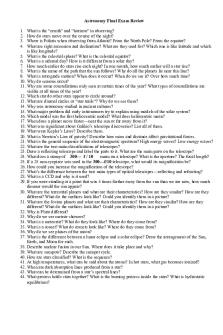Astronomy 100 Midterm 1 Review PDF

| Title | Astronomy 100 Midterm 1 Review |
|---|---|
| Course | Astronomy 101 |
| Institution | Bellevue College |
| Pages | 1 |
| File Size | 40.6 KB |
| File Type | |
| Total Downloads | 90 |
| Total Views | 157 |
Summary
Download Astronomy 100 Midterm 1 Review PDF
Description
Midterm 1 Review Updated Sept. 30, 2019 Vocabulary to know: astronomical unit, light year, asterism, constellation, circumpolar, seasonal, angular size, angular separation, altitude, degree, arcminute, arcsecond, celestial sphere, north and south celestial poles, celestial equator, ecliptic, zodiac, meridian, horizon, zenith, altitude, solstice, equinox, latitude, longitude, waxing, waning, crescent, gibbous, blood moon, super moon, blue moon, harvest moon, synchronous rotation, tidal friction, tidal locking, eclipse season, node, umbra, penumbra, annular, elongation, retrograde motion, geocentric, heliocentric, epicycle, deferent, ellipse, eccentricity, force, mass, acceleration, weight ___________________________________________________________________________ Know the definition and origin of the modern official constellations. Understand angular size and angular separation. Know how to convert arcseconds, arcminutes and degrees into one another. Be familiar with the daily motion of the stars across the sky. Understand how latitude affects what part of the celestial sphere you can see and which stars are circumpolar or seasonal. Know and understand the seasons and the yearly pattern of the Sun’s movement here in Seattle. Know that the seasons in the northern and southern hemisphere are opposite. Be familiar with the seasons at the equator and the North Pole. Understand why our changing distance from the Sun is not the cause of the seasons. Understand precession. Understand the phases of the Moon. Know the names of the phases. Know approx. how long it takes the Moon to move from phase to phase. Know why the Moon (and Sun) appear bigger and redder on the horizon. Know what a blue moon is. Understand eclipses. Lunar: partial, total and penumbral. Solar: partial, total and annular. Understand eclipse seasons and the frequency and duration of eclipses. Know the five planets visible to the naked eye and know the five ways to tell planets from stars. Understand the apparent motions of the planets. Be familiar with the contributions of Aristotle, Ptolemy, Copernicus, Tycho and Kepler and Newton. For Kepler’s Laws and Newton’s Laws, be prepared for simple thought problems like we did in class....
Similar Free PDFs

Astronomy 100 Midterm 1 Review
- 1 Pages

Astronomy Midterm
- 8 Pages

Astronomy Final Exam Review
- 2 Pages

Psychology midterm 1 review
- 19 Pages

Midterm 1 Review Sheet
- 3 Pages

Biology Midterm 1 Review
- 13 Pages

SOC1101 Midterm 1 Review
- 35 Pages

Midterm 1 Review Questions
- 18 Pages

Astronomy Review Questions
- 1 Pages

QTM 100 Exam 1 Review
- 14 Pages

NR 599 midterm review 1
- 10 Pages

Midterm Review Modules 1-3
- 5 Pages

HSS 1101 - Midterm 1 Review
- 19 Pages
Popular Institutions
- Tinajero National High School - Annex
- Politeknik Caltex Riau
- Yokohama City University
- SGT University
- University of Al-Qadisiyah
- Divine Word College of Vigan
- Techniek College Rotterdam
- Universidade de Santiago
- Universiti Teknologi MARA Cawangan Johor Kampus Pasir Gudang
- Poltekkes Kemenkes Yogyakarta
- Baguio City National High School
- Colegio san marcos
- preparatoria uno
- Centro de Bachillerato Tecnológico Industrial y de Servicios No. 107
- Dalian Maritime University
- Quang Trung Secondary School
- Colegio Tecnológico en Informática
- Corporación Regional de Educación Superior
- Grupo CEDVA
- Dar Al Uloom University
- Centro de Estudios Preuniversitarios de la Universidad Nacional de Ingeniería
- 上智大学
- Aakash International School, Nuna Majara
- San Felipe Neri Catholic School
- Kang Chiao International School - New Taipei City
- Misamis Occidental National High School
- Institución Educativa Escuela Normal Juan Ladrilleros
- Kolehiyo ng Pantukan
- Batanes State College
- Instituto Continental
- Sekolah Menengah Kejuruan Kesehatan Kaltara (Tarakan)
- Colegio de La Inmaculada Concepcion - Cebu


